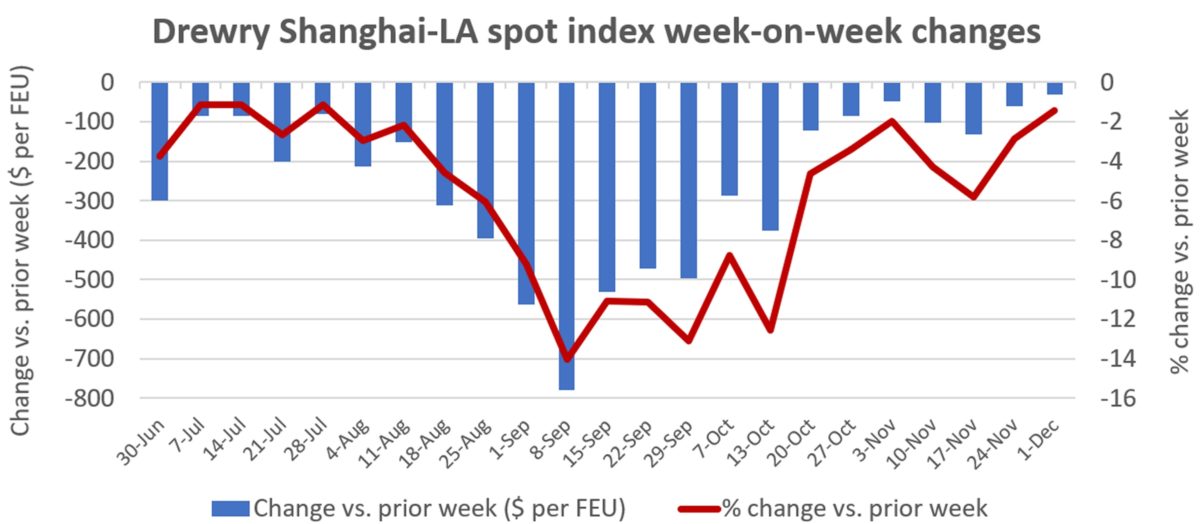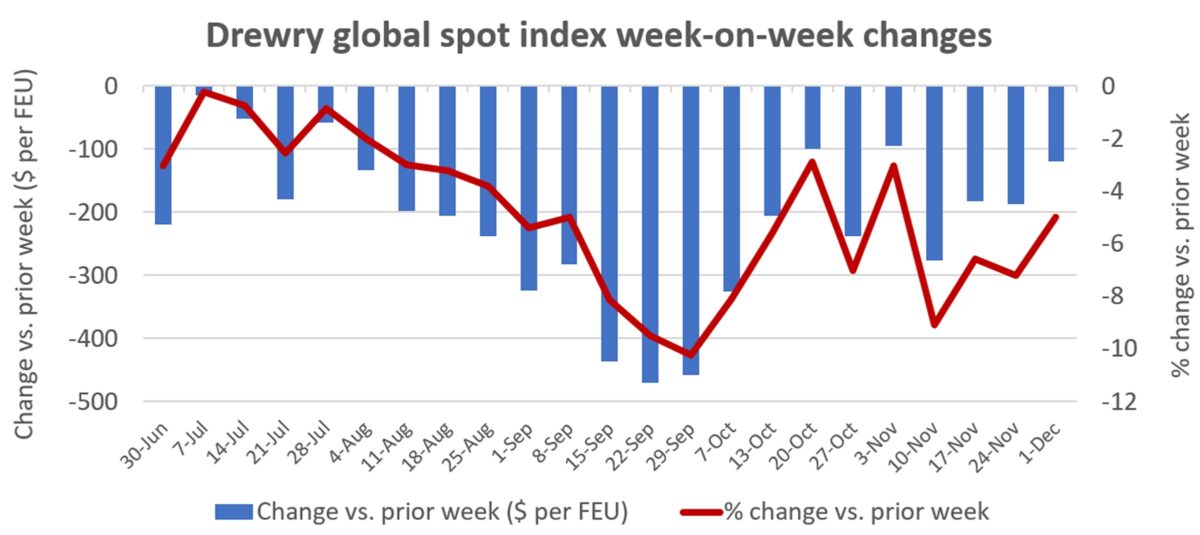So much for the theory that container lines are a nefarious cartel that can control freight pricing — spot rates are still falling over a year after they peaked.
“This cliff that rates have fallen from shows there is more competition in the market than a lot of people had feared,” said Patrik Berglund, CEO of rate-tracking company Xeneta, in a recent interview with American Shipper.
The pace of spot-rate declines did slow in some trade lanes in October versus August and September. However, rate losses picked up again in many lanes in November, causing global averages to fall further. There’s no sign yet of a market bottom in most trades.
Lars Jensen, CEO of consultancy Vespucci Maritime, commented on recent spot-rate action in an online post: “We are coming out of the tunnel, only to discover that the bridge we are driving onto has collapsed.”
Declines since the peak
Different spot-rate indexes provide different numbers but show the same downward trend.
The weekly Drewry World Container Index shows a 78% decline in the global composite rate between Sept. 16, 2021, and Thursday. Drewry’s Shanghai-Los Angeles index fell 84% over that period and its Shanghai-New York index dropped 73%.
The Drewry rate assessments show a gradual decline in the first half of this year, followed by a more precipitous fall starting in August. Despite the huge drop from last year’s record peak, the global index is still 61% higher than the 2019 average, pre-pandemic.

The Freightos Baltic Daily Index (FBX) China-West Coast assessment plunged 93% between Sept. 5, 2021, and Thursday. The FBX China-East Coast rate is down 84% over that timeframe. The FBX global composite is down 75%.
The FBX indexes show a drop in Q4 2021, a plateau in January-April 2022, then a severe decline since May.

Weekly rate of change in trans-Pacific
Spot rates have fallen harder on the Asia-West Coast route than in other lanes. Asia-West Coast spot rates look like they might be close to bottoming, simply because they can’t fall much further. Xavier Destriau, CFO of ocean carrier Zim (NYSE: ZIM), said on Nov. 16: “There is not much more room for a reduction.”
Declines in the Drewry Shanghai-Los Angeles index were fastest in the week ended Sept. 8, when average rates plunged 14% or $780 per forty-foot equivalent unit versus the previous week. Weekly declines eased throughout October and November. In the week ended Thursday, the Shanghai-Los Angeles rate fell only $30 per FEU or 1.4% versus the week before, to an average of $2,039 per FEU.

The pricing dynamic is completely different in the Asia-East Coast trade, where lingering congestion and strong import volumes have kept spot rates higher for longer, meaning they still have plenty of room to fall.
The Drewry Shanghai-New York index fell the most in the week ended Sept. 22: 9% or $776 per FEU versus the prior week. Unlike in the Asia-West Coast market, Asia-East Coast rates show no sign of bottoming and continue to suffer sizable drops. In the week ended Thursday, rates fell 9% or $438 per FEU compared to the prior week.

Weekly rate of change for global indexes
Because of ongoing declines in the Asia-East Coast lane — as well as weakness in other trades such as Asia-North Europe — global composite indexes are continuing to sink.
The Drewry global composite was falling fastest in percentage and dollar-per-FEU terms in late September. It has continued to experience significant weekly drops over the past month. In the week ended Nov. 10, it fell 9% or $277 per FEU.

The most-watched index among shipping analysts is the weekly Shanghai Containerized Freight Index (SCFI), released each Friday. It has displayed the same pattern as Drewry’s global index: falling fastest in September but still showing continued declines in November.

Effect on contract rates
The majority of containerized cargo is moved on long-term contracts, not spot deals.
But spot-rate moves are increasingly important for three reasons: Shippers with contracts are shifting more volume to spot to save money, reducing contract volume; the decline of spot rates to levels below contract rates has compelled shipping lines to lower some existing long-term rates mid-contract; and upcoming negotiations on 2023 annual contracts will hinge on where spot rates end up. Most Asia-Europe annual contracts begin Jan. 1 and most Asia-U.S. annual contracts begin May 1.
Even before those dates, long-term shipping rates are already falling due to new contracts signed at other times of the year as well as existing contracts being renegotiated lower.
The Xeneta Shipping Index (XSI) tracks long-term rates. The global XSI fell 5.7% in November versus October, the largest month-on-month decline since Xeneta launched the index in 2019. The regional index for U.S. import contracts fell 8.9% month on month. The Far East export index sank 8.5%, more than it has in any previous month.
According to Berglund, “We’ve already seen how spot rates have collapsed since summer. We’re now witnessing a ‘catch-up’ as existing [annual] agreements expire and new contracts come into force.”
Ocean carriers could face a particularly painful drop in Asia-U.S. contract rates in 2023 if spot rates do not find a floor soon and continue to decline during the first half of next year. A backdrop of falling spot rates would put ocean carriers in an even worse position when negotiating next year’s agreements.
Click for more articles by Greg Miller
Related articles:
- Plunging spot rates drag down container shipping contract rates
- Zim flew higher in shipping boom, falls faster as market sinks
- Hapag-Lloyd CEO: Container market volatile but not collapsing
- US imports from China falling faster than from other countries
- After steep September slide, US imports stabilize in October
- Shipping rates are no longer plunging. Is ‘new normal’ near?










